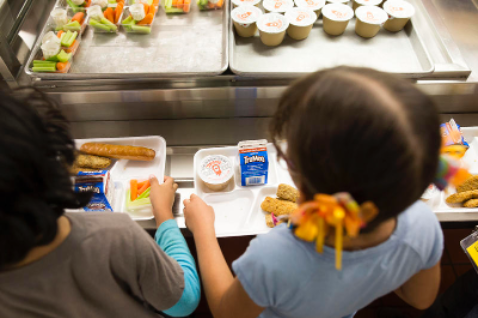Some children grow up fortunate enough to confidently know that a hot meal awaits them once they return home from school. Yet many more children in the United States grow with excitement once lunchtime arrives since it is likely to be their only meal for the day. Families considered low-income, like Tianna Gaines-Turner, her husband and their four children have always been able to access government services to put food on the table.1 The same cannot be said for Jordan and Breanna from Salt Lake City, Utah who suffered from hunger throughout most of their childhood . Jordan and Breanna were eight and twelve when their parents finalized their divorce. Shortly after, their mother received full custody of her children, and like many other struggling single moms, she was unable to consistently provide enough income for her children. This quickly resulted in their becoming homeless. Although Jordan and Breanna represent one end of the spectrum of childhood hunger, their situation is relatively common.2 In both of these stories: both low income families have had to rely on their public schools to provide daily food. Yet, this is a central human right that all other advanced developed democracies provide for, often with direct government subsidies to families. However, this is not the case in the United States. This has led many public schools to be on the front-line of the fight against hunger in low income communities.
The United Nations defines that “The right to food is an inclusive right. It is not simply a right to a minimum ration of calories, proteins and other specific nutrients. It is a right to all nutritional elements that a person needs to live a healthy and active life, and to the means to access them.3” The limitation or uncertainty of the availability of nutritionally adequate or safe foods, otherwise known as food insecurity is currently suffered by one in seven children living in the United States.4 Such food insecurity is notably suggested by the overall health of people in low income communities.5 Therefore, more often than not, members of low income communities struggle with hunger as young children. Additionally, as wealthier children leave public schools to attend charter, private, or magnet schools, low income minority children become even more concentrated in high-poverty public schools, which amplifies the disadvantage for low income and minority children.6
Similarly, low-income minority families suffer from food insecurity more often than other groups because of the growing influence and monopolies of fast-food restaurants. Such fast-food restaurants systemically establish themselves in low-income neighborhoods which increases the communities’ chances of being categorized as a food desert (area with limited access to healthful, fresh, and affordable food). Consequently, in addition to the already existing struggle of overcoming childhood hunger, these low income families live in areas loaded with fast food establishments that foster food-related chronic diseases. Of all the groups who make up the low income neighborhoods in the United States, minorities or communities of color are more often than not the primary victims of poor nutrition and suffer most from childhood hunger.7 Frankly, low income communities are already at a major disadvantage when it comes to depending on a stable and nutrient rich diet causing major concern in ordinary times which have been magnified even further during this global pandemic.
Prior to the COVID-19 pandemic, the Gaines-Turner family, as many other low income families, were already heavily reliant on government programs like the Supplemental Nutrition Assistance Program (SNAP), also known as Food Stamps Program, and food banks. Government programs like SNAP are beneficial to participants, which is why the government should consider increasing available benefits to reduce food insecurity for low income families.5 The pandemic led to the closure of food pantries, schools, and many places of business. The Gaines-Turner family lost its steady income and access to many other supplemental sources of food. Unfortunately, this has been the reality for many families across the United States. With the recent COVID-19 outbreak, the rates of childhood food insecurity have already exceeded those recorded during the 2008 recession.9 How can one of the richest countries continue to allow so many children to go hungry daily? As the Gaines-Turner family struggled to find food options in the midst of the pandemic, spending days where they and their children had no food, similarly Jordan and Breanna faced different obstacles that also resulted in making food scarce in the summer time for them. Those who have endured food scarcity know well that summer time only makes matters worse.

Most children enjoy the arrival of the end of the school year and dwell on all the possibilities that summer break might provide. For others who rely on the free or reduced cost school lunches, they dread summer break because that means they are not guaranteed even one meal each day. This was the case during Jordan and Breanna’s childhood. With the arrival of summer break each year, so too arrived the daunting reality that the siblings had to scavenge for food on a daily basis. Although a free lunch was provided daily during the school year, public schools were not obligated to provide free meals daily throughout the summer break. Some schools opened during summers primarily to offer free lunches are still regulated and often can only provide lunch to students enrolled in a summer program at the school. As a result, Jordan and Breanna were often left to compete with other homeless persons and everyday people to gather sufficient food from food banks or donation pantries.2 As of 2002, over 97,000 schools have participated in the United States Department of Agriculture (USDA) School Lunch Program which strives to provide meals to students from low income communities in an attempt to ensure they are successful in their academic studies.11 Even for those children who are lucky enough to continue receiving free lunches throughout the summer from their school’s lunch program, the food quality still varies drastically between public schools.
The nutrition quality of food programs throughout various public school districts demonstrates another important existing disparity. As expected, lower socio-economic communities receive much less adequate food services than other socio-economic communities. In large part, increased income segregation among neighborhoods contributes to the food program segregation between school districts. Unlike schools in wealthier communities, low income schools are burdened with the lack of funding to keep up with government regulations on nutrition standards and other preventative measures against malnutrition.12 The ubiquitous lack of funding results in large variations in the quality of food provided to students. As a result, certain measures were fairly recently implemented in attempt to narrow this disparity.

In order to amend the USDA guidelines or food programs for children, a Child Nutrition Reauthorization process must take place in which the statute in question may be revised. The latest Child Nutrition Reauthorization process took place in 2010 when First Lady Michelle Obama introduced the Healthy, Hunger-Free Kids Act. This Act not only reauthorized the funding of current child nutrition programs, but it also established the Community Eligibility Provision (CEP), which allowed school districts in high poverty communities to serve free well-balanced breakfast and lunch meals to each of its students and determine meal pricing based on the student’s household income. The existing issue is that even after revisions and amendments are made to USDA guidelines, student participation in such school meal programs are often relatively low. Only 43% of students who were eligible for free or reduced school meals participated in a breakfast meal program and 81% percent participated in a lunch program in 2015. What deters many students from wanting to participate in free school meal programs is the stigma surrounding eligibility for such programs and the lack of communication with parents on the specifics of how the programs work. The Healthy, Hunger-Free Kids Act was implemented to battle such stigma and provide a sense of holistic care by means of meeting every child’s basic right to the access of an adequate food source.13
In order to to provide for their children, the Gaines-Turner family has had to rely on limited services like the recent stimulus check and free school lunch grab-and-go programs which have led them to face more issues of safety for their children. For children who experience food insecurity, the lack of control of a basic necessity like food influences a child’s psychological development. In addition to struggle their children feel a lack of control over basic needs, the Gaines-Turner family seeks new modes of assistance. With only one vehicle and no one to look after their children, they struggle to also find methods in which they as parents may acquire some food donations without compromising their health or the health of their children.1

Back in Utah, upon returning to live with their father, Jordan and Breanna were finally relieved of their fight against homelessness. However, this did not save them from the ongoing struggle of learning to cope with the damages from childhood hunger that they endured for so long.2 Circumstances that fuel food insecurity and in turn have the potential to interfere with the psychological development in young children are long lasting. Consequently, children who are not provided with the necessary nutrients are deprived of reaching full cognitive and behavioral development and adaptation.16 This then implies that child hunger not only affects a child’s struggle for food, but such hunger also continues to affect them negatively later in life.
The Gaines-Turner family continues to rely on their free school lunch programs in order to be able to provide daily meals for their children. Their struggles in dealing with hunger are not likely to be over soon in light of the worsening COVID-19 pandemic. Fortunately, Jordan and Breanna now work at Primary Residential Mortgage, Inc. in Salt Lake City, Utah where Jordan is the compliance assistant manager and Breanna works in file review. They volunteer their time to lead in the fight against childhood hunger and donate as much as they can to the homeless by participating in all kinds of organizations, like Feeding America. Both cases demonstrate the necessity to develop more food programs with the purpose of providing adequate and easily accessible, sustainable healthy food sources for members of low income working communities who struggle with providing for their families. Members of low income communities suffer most when unprecedented events such as the current pandemic reduces access to services that otherwise were previously more readily available. The United Nations emphasizes that since children are completely dependent on their families and guardians, “the choice and capacity of families and caregivers to provide adequate food to them have a significant impact on their enjoyment of their right to food.17” Given that schools were the main stable food source in both cases, we must better support and fund the role that schools play in meeting the basic human right to food for all children in the United States.
- Virginia Sole-Smith, “I Know You’re Angry With Me Right Now Because You’re Hungry,” The New York Times, (2010). ↵
- Colleen Callahan, “Facing Childhood Hunger: Jordan and Breanna’s Story, Feeding America, (2016), https://www.feedingamerica.org/hunger-blog/facing-childhood-hunger. ↵
- Office of the High Commissioner for Human Rights, “The Right to Adequate Food,” United Nations Human Rights, no.34 (2010): 2. ↵
- Amelie A. Hecht, Keshia M. Pollack Porter, and Lindsey Turner, “Impact of the Community Eligibility Provision of the Healthy, Hunger-Free Act on Student Nutrition, Behavior, and Academic Outcomes,” American Journal of Public Health 110, no.9 (2020): 1405. ↵
- David A. Himmelgreen, Rafael Pérez-Escamilla, Sofia Segura-Millán, Yu Kuei Peng, Anir Gonzalez, Merrill Singer, and Ann Ferris, “Food Insecurity Among Low-Income Hispanics in Hartford, Connecticut: Implications for Public Health Policy,” Human Organization 59, no.3 (2000): 341. ↵
- Salvatore Saporito, and Sohoni Deenesh, “Mapping Educational Inequality: Concentrations of Poverty among Poor and Minority Students in Public Schools,” Social Forces 85, no.3 (2007): 1227. ↵
- Andrea Freeman, “Fast Food: Oppression through Poor Nutrition,” California Law Review 95, no.6 (2007): 2222. ↵
- David A. Himmelgreen, Rafael Pérez-Escamilla, Sofia Segura-Millán, Yu Kuei Peng, Anir Gonzalez, Merrill Singer, and Ann Ferris, “Food Insecurity Among Low-Income Hispanics in Hartford, Connecticut: Implications for Public Health Policy,” Human Organization 59, no.3 (2000): 341. ↵
- Lauren Bauer, “The Covid-19 crisis has already left too many children hungry in America,” Brookings, (2020). ↵
- Colleen Callahan, “Facing Childhood Hunger: Jordan and Breanna’s Story, Feeding America, (2016), https://www.feedingamerica.org/hunger-blog/facing-childhood-hunger. ↵
- Keecha Harris, “The USDA School Lunch Program: New Approaches to Meeting the Demands of Child Health and Nutrition in the 21st Century,” The Clearing House 75, no.6 (2002): 310. ↵
- Shiriki Kumanyika, and Sonya Grier, “Targeting Interventions for Ethnic Minority and Low-Income Populations, Future of Children 16, no.1 (2006): 195. ↵
- Amelie A. Hecht, Keshia M. Pollack Porter, and Lindsey Turner, “Impact of The Community Eligibility Provision of the Healthy, Hunger-Free Act on Student Nutrition, Behavior, and Academic Outcomes,” American Journal of Public Health 110, no.9 (2020): 1405. ↵
- Virginia Sole-Smith, “I Know You’re Angry With Me Right Now Because You’re Hungry,” The New York Times, (2010). ↵
- Colleen Callahan, “Facing Childhood Hunger: Jordan and Breanna’s Story, Feeding America, (2016), https://www.feedingamerica.org/hunger-blog/facing-childhood-hunger. ↵
- Marcos J. Martinez, and Elisa Kawam, “A Call to Action for Social Workers: Food Insecurity and Child Health,” Social Work 59, no.4 (2014): 370. ↵
- Office of the High Commissioner for Human Rights, “The Right to Adequate Food,” United Nations Human Rights, no.34 (2010): 16. ↵



26 comments
Camryn Blackmon
Hi Yamel, this piece is extremely informative with great sources, images, and the personal story of a family enduring hunger before and during the pandemic. You brought up such a significant issue that has not yet been resolved but continues to worsen with the various factors you described, including economic losses due to COVID-19 and lack of assistance for low-income students outside of school.
Alexandria Garcia
I never realized childhood hunger was such an epidemic in America. I respect what First Lady, Michelle Obama did when it came to the educational food systems. I personally know families who have benefited from the Healthy, Hunger-Free Kids Act.
Genesis Vera
This was such an informative article that I can tell was thought out and written with emotion. The author makes strong arguments and provides a large amount of data behind it. Using personal stories to emphasize the importance of the article only made the story stronger. Although there was emotion behind this article, I think it only made a positive contribution to the way the article was written.
Victor Rodriguez
A world power like the United States of America and we still have so many children across the country suffering because they live in poor conditions. The government needs to do a better job at looking over children and those living in poverty. One role of government is to protect and provide. it is so sad to see poor children suffering because many do not even have the resources to have food in their homes. The government should be a provider of goods and services so that children like these do not suffer anymore.
Andrew Gallegos
This is such a well informative article and is such a good argument about the education system. It’s important that students get a good meal everyday so they can be able to learn and have that motivation to keep going.
Andres Garcia
this article is such a well-written piece of work! I especially liked that you started by expressing the right to food as an intrinsic human right. Your thorough description of the issue really helps anyone who is new to the subject grasp it completely. I also appreciated the way included the personal stories of Jordan and Breanna to drive the point across. Great job, Yamel!
Caroline Bush
Great article about a topical problem many young people are facing. It is unfortunate that some children rely solely on school lunch to get their daily nutrients. Food should be a guarantee that no child should ever be without but unfortunately that is not the world we live in. I really liked how you lay out the problem and then legislation that has been put in place to help children fight against food insecurity. Great Job!!
Donte Joseph
I really appreciate the creation and idea of this article because food and nutrition are something that I feel is overlooked today. With so much unhealthy foods and the easy access, people can get carried away with not only what they are feeding themselves, but children as well. I did not know that the United Nation included food as a right but I think that it is a great idea especially since many die from starvation.
Allison Grijalva
Hi Yamel! This was a great article and definitely one that hit close to home for me. Food insecurity is an issue that I am personally very passionate about and something that often goes overlooked in society, especially as it pertains to children. I really enjoyed the use of the map of the United States, and how it highlights the most food insecure states with Texas being one of them. Thank you for writing this article and bringing light to a very important issue!
Alexis Lopez
I really enjoyed reading this article because it is very important to talk about the nutrition of the children. It’s important that children get the right food to help start the brain for the school day and have something to help them get through the day after lunch. It also surprises me on the fact that the United States deals with food insecurity because of how much we praise ourselves, yet food insecurity is a reality for a lot of Americans. I loved that you brought up such an important topic that not many people know about.